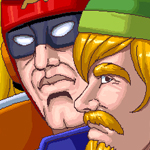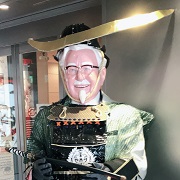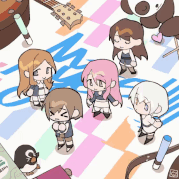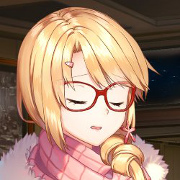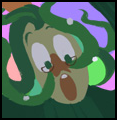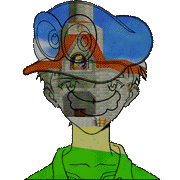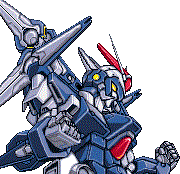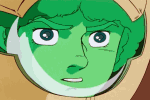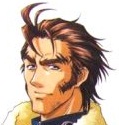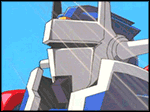|
Silvergun1000 posted:That's what we need, an Aggressors spinoff with Kai as the protagonist. Though I guess at this point the Aggressors have gotten hit with mech inflation as badly as everybody else had. Maybe they could do a 10 chapter long flashback arc featuring the Aggressors and original PTX team (finally introducing all the other SRW4 protagonists), expanding on the Hope incident and twisting around the cover-ups so that Tempest's deal finally makes sense. Oh, and the Valstork was an archaeological find that no one could get to work until it was stolen by a seemingly-random space-pirate mook.
|
|
|
|

|
| # ? May 17, 2024 17:15 |
|
Oh, one other thing Terada said is that it's harder to justify making longer games since he knows his players have less and less time for it. Maybe future SRW games will be shorter? Honestly it wouldn't bother me so much, if they could get to the good stuff from the very first stage rather than spending 15 stages doing warm-ups.
|
|
|
|
Samurai Sanders posted:Oh, one other thing Terada said is that it's harder to justify making longer games since he knows his players have less and less time for it. Maybe future SRW games will be shorter? Honestly it wouldn't bother me so much, if they could get to the good stuff from the very first stage rather than spending 15 stages doing warm-ups. I agree with this, it makes sense to me... But I want the next OG game to be a trip to the goddamn Fireworks Factory.
|
|
|
|
HitTheTargets posted:I agree with this, it makes sense to me... But I want the next OG game to be a trip to the goddamn Fireworks Factory.
|
|
|
|
I can't remember, but wasn't something supposed to be off about the Balmar empire in OG in the earlier games? Like all that was left was an automated war machine?
|
|
|
|
Ethiser posted:I can't remember, but wasn't something supposed to be off about the Balmar empire in OG in the earlier games? Like all that was left was an automated war machine?
|
|
|
|
Samurai Sanders posted:Oh, one other thing Terada said is that it's harder to justify making longer games since he knows his players have less and less time for it. Maybe future SRW games will be shorter? Honestly it wouldn't bother me so much, if they could get to the good stuff from the very first stage rather than spending 15 stages doing warm-ups. As long as we're not talking OG Gaiden levels here.
|
|
|
|
Samurai Sanders posted:Didn't at least one living Balmar person show up in MD? But yeah, it would be an interesting twist if they went there and found nothing. Hell, when playing Alpha 3 I was kind of expecting that but nope, there's an actual empire and emperor there. Yes: the Balsheim clones from A3, who were looking for Euzeth Gozzo, who died in 2nd. Euzeth was apparently still an alien even though he was conspicuously absent back in OG1.
|
|
|
|
Raxivace posted:I've not seen any of these Fate shows but a lion seems like an awfully noble head for a guy as shifty and questionable as Thomas Edison.
|
|
|
|
Endorph posted:Edison is a lion as a joke about him inventing film, and the MGM lion logo. https://www.youtube.com/watch?v=66yo3awHKG8 WORLD FAITH DOMINATION!
|
|
|
|
also the entire london arc of fate/grand order has tesla trying to destroy electricity and enshroud london in fog as revenge for his legacy being ignored, which kinda owns. charles babbage is there too
|
|
|
|
Endorph posted:also the entire london arc of fate/grand order has tesla trying to destroy electricity and enshroud london in fog as revenge for his legacy being ignored, which kinda owns. charles babbage is there too Fitting for this thread, Babbage is a pretty cool looking mech. https://www.youtube.com/watch?v=W1n9wd7xyhE DIMENSION OF STEAM Glorious World of Fiery Desolation
|
|
|
|
FGO's plot is basically SRW with anime history as opposed to giant robots anyway.
|
|
|
|
MonsieurChoc posted:https://www.youtube.com/watch?v=66yo3awHKG8
|
|
|
|
Samurai Sanders posted:Wow that game goes into some silly poo poo, presumably far beyond the hour that I played it, same as all the other f2p smartphone games I have tried. Yeah, having played the japanese version, the good poo poo is still far away in the American version of the game. poo poo will get good in like two Story chapters.
|
|
|
|
I'm going to share SRW Theme Songs For Busy People (again?) apropos of nothing because they always make me giggle. Especially the Super Robot Academy one. Just trust me on that. (Japanese required.)
|
|
|
|
absolute best part of f/go's story/dialogue is when shakespeare wants to make an anime
|
|
|
|
All of the stuff from the Fate series I have experienced is too anime for me and that's really saying something.
|
|
|
|
The fact that FGO still isn't out in Europe disappoints me no end.
|
|
|
|
Samurai Sanders posted:All of the stuff from the Fate series I have experienced is too anime for me and that's really saying something.
|
|
|
|
Endorph posted:Edison is a lion as a joke about him inventing film, and the MGM lion logo. And arguably Edison doesn't deserve the credit for inventing film, at least not solely, but that's a can of worms not fit for the Super Robot Wars thread. Raxivace fucked around with this message at 12:48 on Jul 29, 2017 |
|
|
|
Ethiser posted:I can't remember, but wasn't something supposed to be off about the Balmar empire in OG in the earlier games? Like all that was left was an automated war machine? I believe in 2ndOGs the team ask Mekibos for everything he knows about the Balmar and his response is along the lines of "sorry we don't know poo poo, all we've ever found are automated war machines like the Big White Ball so who even knows if they're still around or if only remnants like that exist" but presumably Euzeth Gozzo yelling about surpassing the Emperor means he still exists. Then in MD more Balmarians show up and one of them is mad, one of them is dreamy and one of them is Cobray and thats pretty much it on that front. It's been a while though so I could be completely wrong!
|
|
|
|
I'm trying my hand at translating that interview that Samurai Sanders linked. Here's a rough draft of page 1 of 3. Much the same way that it's a given in Hollywood movies that American comic book heroes all band together to form team-ups, it's a given in the smartphone world that major games will have crossover events featuring popular anime and comic characters. The "Crossover", the thing that mixes characters from different settings, has become a genre in and of itself. The Super Robot Wars (SRW) series has been using crossovers as its bread and butter for over 25 years running. It's spanned 26 years and over 80 titles since its inception, and it is very much a pioneer in the genre. That said, the crossovers in the SRW series differ markedly from typical collabs, which tend to emphasize marketing for all the latest and greatest. They incorporate the source material and settings of the anime series they draw from, naturally, but they take it a step further. They recreate stories and find ways to take them in new and original directions by playing them off of other series, all while throwing in some deep cuts and in-jokes related to development staff and voice actors. Fans familiar with the source material can enjoy the new twists and ways that some shows intertwine with others, while those not familiar with the shows in question can be inspired through exposure to see new things. That is the essence of the SRW crossover. The most recent title in the SRW series, Super Robot Wars V, was released in February 2017 for the PS4 and PS Vita. We sat down to discuss this with Kinoko Nasu of TYPE-MOON and Takanobu Terada, a leading figure in the SRW scene. Mr. Nasu is the scenario writer of the Fate/Stay Night visual novels. F/SN, like SRW, is a game that emphasizes the concept of a crossover—The story resolves around a Holy Grail War where magicians called Masters summon Servants, representations of historical figures from all different ages, to fight for them in modern day Japan. Fate/Grand Order, the smash hit smartphone game of the same series (over 9 million downloads as of this interview), finally topped 150 Servants, giving the game a massive scale. Mr. Nasu is quite a passionate fan of the SRW series, as he makes clear at numerous points in this discussion. Between the two of them, they drop name after ridiculous name, ranging from the mecha anime featured in the games to the original creations stemming from the games. It's a depth of discussion you'd be hard-pressed to find from another pair of people. This was an impassioned discussion of what direction Japanese character content should be heading in, and how that should be expressed in games. I hope that you can enjoy this particular crossover as much as anything that appears in SRW. Interviewer: TAITAI Writer: Seinosuke Ito Cameraman: Yusuke Masuda Kinoko Nasu's First Encounter with SRW Q: Mr. Nasu, I imagine many of your fans don't know that you're big into the Super Robot Wars series. How much do you love mecha anime? Are there any favorite titles you could name? Nasu: My favorite is Raideen the Brave(*1). I loved the way those two enemy leader guys would front their robot of the week, and they'd make their picks fight to see which one got to go up against Raideen(*2). The first three minutes of the show were hilarious (laughs). It also had a few occult elements that I guess hit the right chord with a guy who would later go on to write fiction. (*1) Raideen the Brave: TV anime that aired from 1975 to 1976. The story of a boy named Akira Hibiki who pilots Raideen, a creation of the Mu Empire, to fight the Yoma Empire that attacked the Mu 12,000 years ago. Yoshiyuki Tomino (who would later go on to create Mobile Suit Gundam) was chief director of the first half (his first chief director role in a mecha anime). (*2) Once directorship swapped over from Tomino to Tadao Nagahama, the Yoma Empire got new management in the form of two brothers named Gorai Kyoretsu and Gekido Kyoretsu. At the beginning of each episode, they would have their Kyoretsu Beasts battle each other, and the winner would get the honor of challenging Raideen to battle. Toward the latter part of the show, the brothers would fuse their Kyoretsu Beasts into one combined creature. Nasu: I never got to see the original Gundam when it was first airing on TV. I never got to watch much anime as a kid. So when I first saw Mobile Suit Gundam III: Encounters in Space (*3), when it was in theaters, I was just blown away. I practically didn't want to leave the theater after the credits rolled. I'll be honest, though—I only know Space Runaway Ideon (*4) from SRW. (*3) Mobile Suit Gundam III: Encounters in Space: Released in theaters in 1982, it is the third and final compilation movie for the original Gundam TV series. It was a smash hit in the box office, topping the revenue charts for animated feature films that year. (*4) Space Runaway Ideon: The mecha anime directed by Tomino following Gundam, it aired in 1980 directly after Gundam finished airing. At the time, it got cut at the halfway point due to unfavorable ratings, but it sent lasting ripples of influence through the anime industry, and to this day, it still commands an enthusiastic fanbase. Terada: Seriously?! Nasu: When I mentioned that to another game creator I knew, he got onto me and said I'd never seen Tomino's finest work (laughs). Nasu: Eventually what happened was, around the time I was 16, my partner Takeuchi (*1) told me, "Gainax is making an anime they're airing on NHK soon. If you don't watch that, we're done!" So I sat down and watched Nadia: The Secret of Blue Water (*2), and that really gave me an appreciation for anime as something fun to watch. (*1) Takashi Takeuchi: Illustrator and dojinshi artist born in 1973, friends with Kinoko Nasu since middle school. Together, they formed the dojin circle TYPE-MOON in the year 2000. He worked as character designer for Tsukihime, as well as successive popular works like the Fate/Stay Night series. He serves as a representative for Notes, the game developer that incorporated TYPE-MOON. (*2) Nadia: The Secret of Blue Water: A TV anime aired from 1990 to 1991, the first TV series directed by Hideaki Anno, who would later create Neon Genesis Evangelion. Based very, very loosely on Jules Verne's 20,000 Leagues under the Sea, it's the story of a circus girl named Nadia with a pendant called Blue Water, and the battles between the secret organization Neo Atlantis and the all-purpose submarine, the Nautilus. (Image taken from NHK Anime World) Nasu: I always wanted to be a novelist, but if I hadn't been exposed to Gainax's work at the time, I probably wouldn't be where I am today. Takeuchi suggested we make a game, and that meant making a transition from the world of text to the world of video games. To me, it was the kind of thing where if I wasn't ready to go in for life, I wouldn't have done it at all. Man, I was such a poser back then... And now I'm in it for life anyway. It's a good life! Q: Interesting. What was the title that got you into SRW? Nasu: I think it was the SNES era that really drew me in. SRW 4 was so much fun. Nasu: Before that point, I saw crossovers as something where you'd just have access to different characters from different settings. Then when I played SRW 4, I saw the game establishing every setting, all while incorporating them together into one new mecha setting. It did more than that—It also included original characters that represented you and gave you a personal window into the setting. Terada: SRW 4 was the first time we used original characters, you know. After the game came out, lots of people sent us back surveys with remarks like, "I loved seeing Amuro say my name." Nasu: Oh, I see. I dabbled with the game a bit, and got surprisingly hooked on it. Nasu: From there, I started brushing up on the series in the game. Mazinger Z (*1) was already a classic, of course, but even Mobile Suit Gundam ZZ (*2) was old by then. It was so neat seeing these older shows being portrayed in a new light using modern technology. (*1) Mazinger Z: A manga and mecha anime created by legendary mangaka Go Nagai, broadcast from 1972 to 1974. The story of Koji Kabuto, who pilots his late grandfather's super robot, Mazinger Z, to protect the world from the evil scientist Dr. Hell. It was the show that formed the archetype of the humanoid robot piloted by a human. It was a huge hit at the time, and its influence can still be seen to this day. Has a new movie coming out in January 2018. (*2) Mobile Suit Gundam ZZ: The third installment of the Gundam series. Directed by Yoshiyuki Tomino, aired 1986 to 1987. It is a continuation of the story of Mobile Suit Z Gundam, with a story focused on the First Neo Zeon Conflict. At First, SRW Wasn't Meant for the Big Leagues Q: Let's talk about how SRW came into being. At the time that SRW first came out in 1991, Mazinger Z and Getter Robo (*) were already considered relics of the past. Were people expecting to get something out of developing a game featuring characters and robots from those shows? (*) Getter Robo: Manga and mecha anime created by Go Nagai and Ken Ishikawa, aired 1974 to 1975. Mazinger Z and Kamen Rider were both major hits at the time, so a Toei producer suggested combining the ideas of a giant robot and transformation, leading to the first combining and transforming robot in mecha anime history. Terada: Not in the least, no. When I first started this, people told me it would never sell. Q: Is that right? Terada: At the time, Banpresto was focused on new characters. SRW was THIS close to getting axed up until around SRW 4. SRW 4 was intended to be the last in the line, but then they told me to make another one. I guess that marked a new beginning for the series. Terada: A lot of what went into SRW 4 was us going "If this is the last one we're doing, might as well!" That's where original characters and karaoke mode (*) came from, among other things. (*) Karaoke Mode: A mode in the SRW series where they show battle scenes from the game while playing the game's midi renditions of theme songs with lyrics displayed underneath, for sing-alongs. This mode was first used in SRW 4 and last used in SRW Alpha Gaiden. Not featured in current games. Nasu: Oh man, I loved karaoke mode (laughs). I'd finish a stage and brew myself some tea, and hum along with the karaoke mode. I also liked that the original mech had its own song. Terada: But back when we did it, I was like, "Why do this when you can just go to a karaoke box?" (laughs). Terada: I was well aware that this was not meant for the big leagues at the time. People would say, "Why bother using old mecha anime?" and I'd be like, "Because I like it, okay? What can I say?" We pretty much did what we wanted to do and believed that there were people out there who would appreciate it. And after doing it long enough, here we are now. Q: So you took all your love for mecha anime and made a game that was a love letter to it. Was the breakthrough idea of new and old super robots appearing together an extension of that? Terada: It started out with the Compati-Heroes Series(*), which featured Kamen Rider, Gundam, and Ultraman. It was the kind of game where the characters would put on mawashi and have sumo battles. That sort of goofy stuff. (*) Compati-Heroes Series: A series of games featuring heroes from different shows like Ultraman, Gundam, and Kamen Rider, where the characters were put into starring roles that broke the molds of their setting. The first title, SD Battle: Heisei Heroes of the Sumo Ring, was released in 1990 for the Famicom, and they have released many more titles in different game genres. They have released new titles since 2012 under the New Compati-Heroes Series banner. Terada: They featured Kamen Riders 1, 2, and V3, and for Ultraman, you had to have the Ultra Brothers. I grew up on that sort of thing being treated as a given, and I got the idea to learn from my esteemed seniors and try the same thing with super robots. Terada: The Fate series (*) does something similar, as does the Avengers, but the idea of heroes teaming up goes all the way back to Journey to the West and Outlaws of the Marsh, right? Man's always had a special place in his heart for that kind of story. Nasu: I think what really stands out to me about SRW is its management. Since this is a game series featuring prominent works of fiction, the idea of killing off copyrighted characters or having terrible things happen to them is pretty much out of the question. But you have this long 50+ hour story that you can carry without dropping a single main character along the way. It can't possibly be easy drawing up engaging stories with these kinds of restrictions. And to do that not just once, but over and over again as a series, all while wowing people with new twists? That takes talent. Terada: Why, thank you. Nasu: Fate/Grand Order (FGO) (*1) is a spinoff of my company's own property, but when we did a collab with Fate/Kaleid Liner Prisma Illya (*2), which was handled by Kadokawa, we had to deal with a lot of ground rules. If it's that hard when it's our own company's work, I can only imagine how bad it is dealing with other companies' copyrighted works. (*1) Fate/Grand Order: An iOS/Android smartphone RPG first released in 2015, in which the protagonist controls three Servants that fight in turn-based tactical combat. Its story is huge, clocking in at over 1 million characters of Japanese text. It hit 9 million downloads as of May 2017. There is a version for China and Taiwan, as well as a release slated for North America on the horizon. (*2) Fate/Kaleid Liner Prisma Illya: A spinoff of Fate/Stay Night featuring Illyasviel von Einzbern as a magical girl. Started out as a comic, then branched out into anime and games. (Image taken from Fate/Kaleid Liner Prisma Illya official movie site) Nasu: Considering that, the heroes featured in SRW are all stars that have to represent their respective series. There must be a ton of limitations involved. You could never weave all of those stars into a single tapestry if you didn't have some serious management. It takes not just game development, but a whole lot of diplomatic wrangling with outside parties. Q: Many people wonder how SRW negotiates with rightsholders at all. Terada: Let's be real here—All we do is take other content creators' hard work, find points of commonality between them, and mash them together. We're not building a massive setting from scratch like Fate does. Since this is copyrighted work, we do deal with a lot of restrictions, but our production pains are nothing compared to a completely original game. We didn't invent Mazinger Z or Gundam. All we're doing is using preexisting characters to write "Wouldn't it be cool if" stories. If anything, we're doing the writing equivalent of figuring out how to glue different plastic models together. Terada: Not being able to futz with the series we use is both a blessing and a curse. If I'd been given a project like Fate to work on, I might have let myself be overly restricted by the historical backgrounds of the people the Servants were based on. Then I see FGO, where it's like, "Why does this dude have a lion head?" (*) (laughs) (*)Lion Head: Referring to the Fate/Grand Order Servant incarnation of Thomas Edison, who has a human body with a lion head. Nasu: That's creative freedom (laughs). Terada: The idea of comparing SRW to an original work like Fate with that degree of creative freedom and expressiveness is just ridiculous on its face. Nasu: SRW uses stars from different shows, while the Fate series lets me do pretty much whatever I want within what my own company allows. They're both similar and very dissimilar, huh? Nasu: I got into SRW with 4, but what really cemented my interest was the SRW Alpha series. Admittedly, I've barely had any free time since FGO started, so I haven't had a chance to play SRW V yet. Nasu: The capstone to the Alpha series, Super Robot Wars Alpha 3: To the Galaxy of the End, was a game that had powerful enemies that needed the game's all-star lineup to defeat, and had stage after stage that kept upping the stakes. Pretty much everyone thought this would be too hard an act to follow, that this had to be the end of the SRW series. But no, it kept right on going with the SRW Z series. That spirit of just pouring your all into what you're doing now, and worrying about the rest later, that's something I take with me into FGO now (laugh).
|
|
|
|
Raxivace posted:That's still a little weird since Edison didn't really have anything to do with MGM Studios but okay. Edison's schtic in F/GO is that all his poo poo is actually stolen, modified and mass produced. All of his troops in story for instance are in mech suits, which were Babbage's autonomous steam mechs originally, just painted in American Flag colors. Its kinda silly. Also he's president Edison fighting the Celtic hordes with a Russian philosopher and Indian demigod by his side.
|
|
|
|
You forgot to mention the bit where his combat suit is magically empowered by the patriotic spirit of every American President in history.
|
|
|
|
Hokuto posted:Q: Mr. Nasu, I imagine many of your fans don't know that you're big into the Super Robot Wars series. How much do you love mecha anime? Are there any favorite titles you could name? For anyone not familiar with the show, this clip from episode 9 of the show, featuring Akira (the hero) and Prince Sharkin (villain, here disguised as a bishoujo transfer student) challenging each other to a game of soccer, should give you the gist of how the show works. https://www.youtube.com/watch?v=4quXc9liq7g
|
|
|
|
Schwarzwald posted:For anyone not familiar with the show, this clip from episode 9 of the show, featuring Akira (the hero) and Prince Sharkin (villain, here disguised as a bishoujo transfer student) challenging each other to a game of soccer, should give you the gist of how the show works. Holy poo poo this rules
|
|
|
|
Hokuto is way better a translator than our community deserves, but am I glad to have her around.
|
|
|
|
Ryoga posted:Hokuto is way better a translator than our community deserves, but am I glad to have her around. That is one of the nicest things I've ever heard, thank you. Just for that, here's page 2 out of 3! Delving into SRW Development Q: I'd like to talk about the development process for an SRW game. Where do you start when drawing up a new title? Terada: We start with the series roster. We can't exactly write out a story if we don't know what all's going into the game. Q: Once you get the roster defined, what then? Terada: SRW games tend to have a lot of heavy hitters on your main team, so the real trick is deciding what to do about an original last boss for them to fight. Terada: So we start by asking ourselves, what's the biggest-scale property we've got on the roster? Like are they going up against some huge galactic empire, then fighting some random dude? (laughs) I mean, it happens, sure. But we have to lay out foreshadowing so that when it happens, it's a payoff rather than a letdown. Nasu: So you settle on a final boss and ultimate destination, then you start writing from there. Terada: Well, you never put off figuring out the bosses when you're working on a video game anyway. That's kind of important. Nasu: I'll tell you this. I was floored when that Spirit Emperor Keysar Ephes (*) showed up. (*) Keysar Ephes: The true ruler of the Ze Balmary Empire, an interstellar empire featured in the SRW franchise. He is the last boss of SRW Alpha 3: To the Galaxy of the End, and he is voiced by Ichiro Mizuki, a pioneer anime singer with deep ties to the SRW series. Terada: Wow, really? Nasu: I was NOT expecting Ichiro Mizuki (*) of all people! His attacking lines were so good. It was such a fitting climax to cap off the Alpha series. I'll always be impressed with just how grand the endgame and enemies were, and how fitting it was for the series being included. (*) Ichiro Mizuki: Singer born in 1948, AKA Aniki, AKA the king of anime songs. He has sung a number of famous theme songs over the years, including the well-known main theme for Mazinger Z. He also does voice acting, narration, and songwriting. Always Agonizing over the Last Boss Terada: Thank you kindly. That said, I don't think every final boss we make is a success. In fact, I personally think we have more that fell flat than those that succeeded. Terada: We ask ourselves, "What is the fundamental evil?" but Brave Express Mightgaine already took the best option, "The god that made everything", which itself is great. Because we saw that at the time, we never quite reach that point. Terada: I don't write out the scenarios now, but I do jot down notes for final boss ideas when they come to me. Good bosses help to make better use of some series, especially when you're not sure what to do with them. (*) Brave Express Mightgaine: A TV series that aired 1993 to 1994, first in the Brave franchise, about a boy named Maito Senpuji who pilots the brave robot Mightgaine to battle evil. When Maito faced the evil mastermind Black Noir in the final episode, Black Noir referred to himself as a three-dimensional person while claiming Maito and his team were just game data in a two-dimensional world, a very meta plot twist. They did not delve too deeply into this idea in the show, but in the ending of the final episode, there is a cel image of Maito and the female lead having a wedding. Nasu: That makes sense. A game's theme and their bosses are very much two sides of the same coin. When I write, I need a boss to utilize a particular theme to its fullest and draw a line to a given conclusion before I can even start writing. The moment I settle on the theme I can write for a given boss is the moment that the green light goes off in my head, I guess. Terada: If only someone wrote a book called How to Make a Good Final Boss. (laughs) Nasu: Oh god no, you can't put that in a manual, we'd all be out of a job. (laughs) SRW in particular is a long-running series, so I imagine it can't be easy coming up with a good repertoire of bosses. Terada: One scrapped suggestion I made was the idea that the original protagonist was the final boss. I said, "The level of the main protagonist that the player's nurtured all this time will directly impact how strong the last boss is!" and my staff gave me some pushback like, "The players would be so pissed." It works in movies and novels, but in video games? People would get annoyed if we did it in SRW. Nasu: I guess there are some curveballs you can't get away with when a game's over 30 hours long. Even 20 hours can be too much in modern gaming. People just don't have the time to spend on gaming that they used to. Terada: In mecha anime, they fully establish how you'd defeat the last boss, and what kind of banter and dialogue you'd have leading up to that point. But in video games, you do all of that yourself, so it's supposed to be hard, right? I guess that doesn't count when we're including action games where the final battles are controlled by the player, but the point remains. On the other hand, if you overplay your hand with the last boss and have it overshadow the established characters too much, that can leave a sour taste in people's mouths. Nasu: That's the tricky thing about SRW, isn't it? Personally, I'd love the kind of ultra-cheap boss that could wipe out 40 established characters, but I get that. A big part of SRW is walking that tightrope between wanting to go big and not wanting to step on the players' toes. SRW Is an Embodiment of Player Dreams Q: We've shined some light on the process for writing villains, but what about the hero side? That looks tricky to me. Terada: Unlike the villains, we don't get full control over the hero lineup. Sometimes we include things pretty much because they're popular at the time. Nasu: What kind of choice lineup do you look at when considering what the players want to see in the next SRW title? Terada: It's changed a lot over time. Back in the old days, it was pretty simple to pick stuff out. Nowadays there's a lot more to it—Surveys, shows that are popular and must-haves, shows that have upcoming new releases, and so on. We take all of that into account when we're drawing up our initial roster. Q: I see you take external input seriously. It's the sign of a good producer, but as a creator, does it ever get hard not being able to just pick what you want? Terada: I'll start by saying, there isn't a single mecha anime that I actively dislike. That said, I do sort of write scenarios, so sometimes I do wish that just once, we could work with a roster solely driven by writer preferences. It would make the writing so much easier. Nasu: Yeah, then you could go full fanboy mode. That's both a fun prospect and kind of scary. (laughs) Terada: There's this show called Super Dimension Century Orguss (*) which is pretty much the premier anime about intermingling worlds. The story setting transitions through lots of different worlds, kind of a patchwork. (*) Super Dimension Century Orguss: TV series broadcast in 1983-1984. It was the second in the Super Dimension franchise, following Super Dimensional Fortress Macross. In this story, the protagonist, Kei Katsuragi, triggers a Space/Time Oscillation Bomb that throws the Earth into chaos, mingling multiple different worlds together. Kei gets sent 20 years into the future, where he gets caught in a tug-of-war between multiple sides that seek him out as the Singularity that holds the key to restoring dimensional balance. Terada: It was amazing back when it was first shown on TV, and I wanted to include it in an SRW game some day. Eventually, I did end up making use of the Orguss setting in the Z series to bring in multiple worlds. I leaned on Orguss for a plot device to make it easier to incorporate different ideas like calling people from the ends of the galaxy to the Earth Sphere, or having AT battling from Armored Trooper Votoms (*1) going on in the Shinjuku Ghetto from Code Geass: Lelouch of the Rebellion (*2), things like that. (*1) Armored Trooper Votoms: TV series that aired 1983-1984. Many consider it the peak of real robot anime due to its hard-boiled storytelling and military hardware depictions. Battling is when armored troopers (ATs) fight each other in money matches. (*2) Code Geass: Lelouch of the Rebellion: TV series that aired 2006-2007. The setting is a world where Japan is under occupation by the Holy Britannian Empire. Japan is referred to as Area 11, and the native Japanese are referred to as Elevens and shipped off to live in the ghetto. A boy named Lelouch Lamperouge is given the Geass, a power of absolute compulsion, by a mysterious girl named C.C., and he starts a rebellion against the Holy Britannian Empire to find out the truth behind his mother's death and to get revenge against his father, the emperor of Britannia.
|
|
|
|
Hokuto, thanks so much for translating all of this. Reading Terada and Nasu geek over Orguss and Might Gaine is fantastic.Hokuto posted:Holy poo poo this rules Raideen is terrible, but it absolutely rules.
|
|
|
|
Schwarzwald posted:For anyone not familiar with the show, this clip from episode 9 of the show, featuring Akira (the hero) and Prince Sharkin (villain, here disguised as a bishoujo transfer student) challenging each other to a game of soccer, should give you the gist of how the show works. i miss Shin-Getter Subs  Endorph posted:Edison is a lion as a joke about him inventing film, and the MGM lion logo. https://www.youtube.com/watch?v=Yv7UL5WATNs BornAPoorBlkChild fucked around with this message at 04:48 on Jul 30, 2017 |
|
|
|
Schwarzwald posted:For anyone not familiar with the show, this clip from episode 9 of the show, featuring Akira (the hero) and Prince Sharkin (villain, here disguised as a bishoujo transfer student) challenging each other to a game of soccer, should give you the gist of how the show works. https://www.youtube.com/watch?v=8F9jXYOH2c0
|
|
|
|
Really a shame about Shin-Getter. I watched the few episodes of Yuusha Raiden that they subbed, and I liked what I saw. At least we got Zambot 3 and Space Runaway Ideon. Hokuto posted:(*) Brave Express Mightgaine: A TV series that aired 1993 to 1994, first in the Brave franchise, about a boy named Maito Senpuji who pilots the brave robot Mightgaine to battle evil. When Maito faced the evil mastermind Black Noir in the final episode, Black Noir referred to himself as a three-dimensional person while claiming Maito and his team were just game data in a two-dimensional world, a very meta plot twist. They did not delve too deeply into this idea in the show, but in the ending of the final episode, there is a cel image of Maito and the female lead having a wedding. 
|
|
|
|
At the very least /m/ Subs has picked up where Shin Getter left off with Raideen...at the rate of about one episode per six months, granted. Also gonna agree that it is seriously cool of Hokuto to translate that interview.
|
|
|
|
Raxivace posted:

|
|
|
|
And here's page 3. What Does Kinoko Nasu Want in SRW? Q: By the way, Mr. Nasu. Are there any mecha anime you totally want to see in an SRW? Terada: For the record, like I said before, I can't make any promises. (laughs) Nasu: Hmm. I guess the biggest prospect from our side of the industry, Demonbane (*1), has already made it in. I love the comic Shin Mazinger Zero (*2), so I almost flipped when I found out it was in SRW V, until I found out it was just the unit. I'd love it if they could put something in like the final chapter of that story. (*1) Demonbane: Started out as Zanma Taisei Demonbane, an 18+ adventure game released by Nitroplus in 2003. It is the story of Kuro Daijuji, a private detective who forms a pact with a tome named Al-Azif that takes the form of a young girl. He pilots the giant robot Demonbane to do battle against the Black Lodge secret society. In 2004, it was adapted into a PS2 game intended for all ages called Kishin Hoko Demonbane, which had a TV anime series adaptation in 2006. It is featured in Super Robot Wars UX(2013, 3DS) under the title Kishin Hoko Demonbane. (*2) Shin Mazinger Zero: Comic created by Go Nagai, written by Yoshiaki Tabata, drawn by Yuki Yogo. To change a future where Mazinger Z turns into a demon god and destroys the world, the android woman Minerva X loops through multiple different histories. The story continues in Shin Mazinger Zero vs. the Great General of Darkness, with the appearance of Mazinger Zero, the one and only super robot to fully turn into a demon god of destruction. In Super Robot Wars V, it shows up under the branding of this sequel. The climax of the story that they're referring to in this discussion is something way too awe-inspiring and impactful for text to ever do justice, so this writer strongly recommends that you read it for yourself. (Image taken from Akita Shoten official website) Terada: That's an unfortunate consequence of being in an SRW story, yeah. I feel bad for the Shin Mazinger Zero comic, in a way. Some people probably saw it in SRW V and assumed Mazinger Zero was a friendly robot that Koji Kabuto piloted. It sure isn't that in the comic. Nasu: If anything, it's deserving of being a final boss itself. (laughs) Nasu: What I've gotten out of this discussion so far is that if you had to sum up SRW in a word, it would be dreams. Many players wish their favorite characters got more screentime, but stories are made to be consumed. Once you're done consuming them, they're in the past. But even when the story is a thing of the past, the characters still remain. SRW embodies that player dream of giving their favorite characters more screentime. The dreams of the players, the characters that the writers want to make, and the wishes of the corporate bigwigs. (laughs) It's those three things combined that make SRW what it is, in my view. Terada: The writers have tons of ideas about the kinds of stories they want to do, but very few of them see the light of day. Even in the older SRW titles, there was never an instance where we said, "This was the best crossover possible," or "Everything worked out perfectly." There's always something that doesn't work out the way we want, always a title we wish we could include but can't, for whatever reason. Q: Mr. Nasu, I was impressed by your remark about the characters remaining even when the story's been consumed. Fate is very much a franchise where the characters remain and show up in lots of derivative works. They're not even limited to video games. Is that sort of awareness something you keep in mind? Nasu: Oh, it's not something I've been actively conscious of. Fate started out as an homage to Makai Tensho (*). There was this crappy story I wrote back in school when I wanted to do my take on Makai Tensho. My partner Takeuchi remembered that and said, "Let's make a video game out of that." That's how Fate/Stay Night came to be. (*) Makai Tensho: A fictional novel written by Futaro Yamada, first in the Ninja Scrolls series. The story is about Jubei Yagyu fighting real life swordmasters that have been brought back from the dead to destroy the Tokugawa shogunate. It is most well-known for its theatrical release in 1981 (Samurai Reincarnation) directed by Kenji Fukusaku, and in addition to a new theatrical release in 2003, it has been adapted to many mediums, including anime, stage plays, video games, and a comic by Ken Ishikawa. (Image taken from Kadokawa Shoten official website) Nasu: I wrote the original story back in my student days, and all I wanted to do was have the characters get violent. It was a long time afterward when I made Fate/Stay Night, so I was ready to make it into a proper story. When a story ends, typically the characters' job is done, and there's nothing else to add to that. But the players loved the characters to a degree I'd never expected, and the characters ended up being darlings of ours to some extent too, I guess. Fortunately for me, I'd written the story to share a world view with my other works. The incident in this one city is over, but wouldn't it be cool if this character was around for the next incident? I wanted to just keep going on a lark like that, and... Well, here we are now. Nasu: The characters we create are our babies, really. What parent doesn't love to see their children grow? Normally, you'd be expected to let go of your children once you're done writing one story. But I had the chance to do more, so I guess figuratively, I've watched my babies go from elementary school to middle school, to high school, to college, and now they're leaving the nest and getting married, yet here I am still babysitting them. I guess that's how I feel about Fate. Nasu: That said, Arturia (*1) and Emiya (*2) have fully completed their arcs as characters, and I have little desire to write more stories centered around them. But newly born Servants haven't had stories told about them yet, so you know, if the chance presents itself... My stance is that I'd write it if someone made me. (*1) Arturia: The Saber-class Servant summoned by Shiro Emiya, the protagonist of Fate/Stay Night. Her true name is Arturia Pendragon. She is supposed to represent King Arthur of medieval English lore, if King Arthur was really a beautiful woman disguised as a man. (*2) Emiya: The Archer-class Servant summoned by Rin Tohsaka in Fate/Stay Night. Archer's true name of Emiya is a focal point of the second Fate/Stay Night route, Unlimited Blade Works. No Right Way to Define a Robot's Strength Q: I'd like to hear more about the travails of making SRW now. What kind of sticking points are there, other than the series roster and the final boss? Terada: It's tricky defining a robot's stats and weapon strength. Even the creators of Gundam haven't clearly defined which one is the strongest out of the Gundam, the Z Gundam, the ZZ Gundam, and the Nu Gundam. Yet we're supposed to sit in a room and decide this stuff. How do you tell whether Chodenji Spin (*1) is stronger than Tenkuken V Slash (*2)? The simple answer is, you don't. (laughs) (*1) Chodenji Spin: Superelectromagnetic Spin, a special attack used by Combattler V, from Chodenji Robo Combattler V, broadcast 1976-1977. (*2) Tenkuken V Slash: Heaven Sword V Slash, a special attack used by Voltes V, from Chodenji Machine Voltes V (Five), broadcast 1977-1978. Voltes V was broadcast directly following Combattler V, and the two series often co-star in SRW games and get team-up attacks together, but the stories have no actual connection. Nasu: Ideally you'd want them even, huh? Terada: Right. But we add tweaks, like having Voltes V be a little stronger due to being the later entry, giving it higher attack power values and heavier energy consumption, that sort of thing. There's no right way to balance it. That doesn't just go for established characters, either—There's no right way to balance it even when it's all original characters. It's always tricky when you have a game with a large cast of frontrunners. Terada: The easiest one to balance is the Ideon, really. Take its wave motion gun. Range: Max. Attack power: Max. Done! (laughs) When you use it, its range covers a huge part of the map in red squares. And even then people sometimes tell me it's not powerful enough. Terada: It's never easy to work out consistency in a story. There are things I want to show off in a scenario, but I have to constantly wrack my brain over how to balance it for a simulation RPG. When I'm feeling lost, I take another look at old Kamen Riders and Ultramans to remind myself what a crossover is. Old crossovers are super simplistic, you know? In The Return of Ultraman (*), Ultra Seven would show up with no real explanation, hand over the Ultra Bracelet, and leave again. (laughs) (*) The Return of Ultraman: A tokusatsu show broadcast 1971-1972, the fourth entry in the Ultraman series. It was originally supposed to be about the first Ultraman coming back to Earth, but due to a last-minute sponsor decision, it ended up being a new Ultraman named Ultraman Jack. Nasu: Well, they're brothers. (laughs) Terada: I find Ultraman Taro (*) especially exciting. Sure, it's a kids' show, but it's a huge departure from earlier Ultra predecessors, and I love it. Kids' shows tend to emphasize impact more than consistency, in a good way, and kids eat that stuff up. So basically, when in doubt, I watch Taro. (laughs) When you get a bunch of devil-may-care shows like Taro in one place, it's easy to feel that same mindset. (*) Ultraman Taro: A tokusatsu show broadcast 1973-1974, the sixth entry in the Ultraman series. It was the first full portrayal of the Ultra Family that had been hinted at in previous shows. Unlike previous entries, it was styled closer to a family drama, with a lot of comedic elements. Nasu: So it spurs you to just go for the gusto? Terada: Exactly! Like when we put Tengen Toppa Gurren Lagann (*1) in SRW, I just couldn't figure out what to do about the Tengen Toppa thing. I talked with the (Gurren Lagann) script writer Kazuki Nakashima about it, and he gave a gracious suggestion, "Everybody's Tengen Toppa." (*2) (*1) Tengen Toppa Gurren Lagann: TV anime broadcast in 2007 that also got two theatrical compilation movie releases. The story of a young boy named Simon who pilots a face mecha called a Gunmen to fight against beastmen. As a member of Team Gurren, led by the brother figure Kamina, he grows through a number of different adventures. The story is made up of four arcs, through which the scale grows increasingly grandiose. (*2) "Everybody's Tengen Toppa." In the final battle of Tengen Toppa Gurren Lagann, Simon and the rest of Team Dai-Gurren face off against the Anti-Spiral, a being that exists beyond time and space. In Super Spiral Space, where perception becomes real, Simon's robot Gurren Lagann takes in the thoughts of Team Dai-Gurren and achieves Tengen Toppa, growing bigger than even galaxies, to fight the Anti-Spiral. When this scene happens in SRW Z3: Jigoku-hen, the surprise twist is that every other copyrighted robot there also goes Tengen Toppa and stands shoulder to shoulder with Tengen Toppa Gurren Lagann, allowing all of them to fight on the same map. Nasu: See, that's something Mr. Nakashima can get away with saying, since he's the original script writer for the show. We could never get away with that. I mean, Tengen Toppa was a special privilege reserved just for the main characters of the show, after all the development and story arcs they went through. You can't just give that out to others like candy, not unless you were part of the original production. Terada: Well, that goes both ways. We also got specific requests from Mr. Nakashima about what parts of the story he absolutely did not want changed from the original. I can't say which ones. Sometimes it's okay to delve into what-if scenarios, and sometimes you have to stick to the script. That's just how it goes when you're handling other people's characters. Terada: Fate has a lot of that absurdity in a good way, too. I love the idea of the true name (*). There's something romantic about hiding your true name and having it come out. (*) True Name: The Servants summoned by Masters in the Fate series are referred to by their class name (ie, Archer or Saber). Their true names as Heroic Spirits are kept hidden, for the reason that since the Servants are figures from history and legend, their true names can give away their gimmicks and weaknesses. Nasu: It's the whole thing of having a character be cool at a glance, but knowing there's more to them than their appearance. It's like figuring out the cuplrit in a whodunnit, there's always something engaging about that. Terada: It can be a major plot hook in a story, "What's their real name?" But you can't do that in an SRW. After all, you can't just bust out a series that wasn't planned on the roster. Nasu: Oh man, I'd love to see that! Nothing would be cooler than if you could pull off a surprise mystery entry in an SRW. Terada: I'd love to do it, but you can't do that with marketing, you know? (laughs) Terada: As far as in-game surprises go, we can get away with more in the Super Robot Wars OG series, where it's all original characters. We go for the really old deep cut enemies there. Nasu: Oh, like when XN-L (*) showed up? (*) XN-L (Zan-el): The final boss of Super Robot Wars OG: Moon Dwellers, released for PS3 and PS4 in 2016. Zan-el was the final boss of the first SNES Compati-Hero game, The Great Battle II: Last Fighter Twin, released in 1992. It made a surprise comeback in OG over 20 years later. Terada: Wow, you know your stuff! I'm kind of touched. (laughs) But we could never pull off a surprise appearance of a licensed character not on the roster in a regular SRW game. In that sense, Fate has a very well-crafted story gimmick. Q: Well, how about next time, we have Mr. Terada take a turn asking Kinoko Nasu about Fate? I hate to cut this off right as the roundtable reaches an interesting point, but that's all for this issue. You can read the rest in a future installment. (There were some writer remarks following this, but each of these pages took 3 hours so I'm just gonna call it done here) Hokuto fucked around with this message at 20:19 on Jul 30, 2017 |
|
|
|
Hokuto posted:Even the creators of Gundam haven't clearly defined which one is the strongest out of the Gundam, the Z Gundam, the ZZ Gundam, and the Nu Gundam. I'll give them the latter three, but let's be real here.
|
|
|
|
Echoing the appreciation for all you do Hokuto! Someone was asking me about how they choose what story beats to keep and what to mix up and it turns out the answer is pretty much "it depends on the what the creator says" with I guess the full spectrum being anything from free reign without even any input do whatever the hell you like i don't care to complete micromanagement of making it happen exactly how it did. I can definitely see a room full of writers trying to come up with cool final boss concepts and it just playing out like a Simpson's did it joke. Brunom1 posted:I'll give them the latter three, but let's be real here. Agreed, only one of those beat Big Zam and is thus clearly the most powerful.
|
|
|
|
This interview is super insightful stuff. quote:Nasu: What I've gotten out of this discussion so far is that if you had to sum up SRW in a word, it would be dreams. Many players wish their favorite characters got more screentime, but stories are made to be consumed. Once you're done consuming them, they're in the past. But even when the story is a thing of the past, the characters still remain. SRW embodies that player dream of giving their favorite characters more screentime. The dreams of the players, the characters that the writers want to make, and the wishes of the corporate bigwigs. (laughs) It's those three things combined that make SRW what it is, in my view. I've never been interested in anything from Nasu but this makes me want to buy him a drink. Reading him and Terada geeking out together is good. Also, I'm amused that the idea for how to handle the TTGL finale in Z3 came out from the script writer and. Knowing that they also ask creators just how much of the original story can be changed is very interesting, especially when you think that Fukuda supposedly wasn't too excited about how much people in general (including Shinn's VA) liked Z's changes to GSD. I'd love to be a fly on the wall listening to these conversations where the staff figures out how and why to change each series' plot.
|
|
|
|

|
| # ? May 17, 2024 17:15 |
|
Brunom1 posted:I'll give them the latter three, but let's be real here. I'd totally buy into the RX-78-2 being such an overdesigned pile of hardware that it stays competitive even when compared against its successors, but that suspension of disbelief dissolves ingame when later UC stuff doesn't revolve entirely around beam weapons and designing your way around them. My boy the 78 is immune to ballistic weapons shy of a bazooka. Meanwhile, the Victory would probably get shredded by a vulcan. To do this properly, they'd have to change the beam damage formula, though. That's a whole other discussion.
|
|
|


